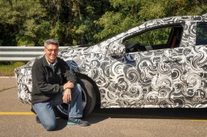Camouflaging New Chevrolet Volt is Balancing Act
 Chevrolet Volt Chief Engineer Andrew Farah (pictured) and his team have been driving camouflaged 2016 Volts to validate ride, handling and powertrain performance. “If not for the work done by the camouflage engineers, we couldn’t test these pre-production vehicles in their natural environments,” he said. “It’s critical for us to make sure we’re listening to customer wants for the next generation Volt, and the only way to do that is to be out in the wild, while keeping the design under wraps.” |
Engineers charged with hiding styling while vehicle testing proceeds in public
DETROIT -- Sept. 29, 2014: The styling of the next-generation Chevrolet Volt is one of the automotive world’s best-kept secrets. Keeping customers and media eager to see the successor to the groundbreaking original at bay until the new Volt debuts at the North American International Auto Show in Detroit in January is tricky business.
First, it is engineers, not designers, who are charged with creating camouflage that balances styling secrecy with the need to validate the Volt and its systems in public.
“If it were up to me it would be a shoebox driving down the road,” said Lionel Perkins, GM camouflage engineer. “The design team wants us to cover more of the vehicle and the engineering team needs to have enough of the vehicle’s weight and aero exposed so that the tests in the development process are consistent with the product that will come to market.”
The engineers responsible for the “cool” designs covering the car might deserve style points but their efforts are intended strictly to hide the metal beneath.
Some of the tricks of the trade:
Black and white patterns – The color scheme creates a shadow that hides vehicle design elements. 3D – Layered camouflage throws off onlookers, but has to be applied without interrupting airflow around the car. Swirls – In the old days of car camouflage, the design relied mainly on a grid pattern, but over the years engineers discovered that grids are difficult to realign if a piece is removed to make a change to the car. Swirl patterns better hide such developments. Bubble wrap – Camouflage can be made from many different materials including plastics, vinyl and foam. Good, old bubble wrap is a lightweight, easily attachable three-dimensional material used to confuse prying eyes. The camouflage package on the next-generation Volt was started six months in advance of early development. Every vehicle is different and tricks are constantly updated to keep spy photographers and the curious guessing.
“Each car is unique. We are like a dress maker, and the car is our model,” said Perkins. “No two models are the same. We need to make the right dress that fits the body we are dealing with.”


